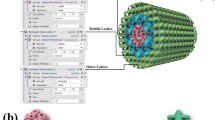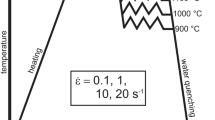Abstract
In this study, an improved discrete element model (DEM) is developed to understand the defect effect in ceramic cracking process. First, model parameters based on the linear parallel bonding model are calibrated using microcell deformation experiments and orthogonal experimental design methods. Then, the uniaxial compression of ceramics with different crack lengths and inclination angles are simulated. The crack initiation and propagation processes are illustrated with displacement and stress fields. The results show the predicted crack patterns are qualitatively in agreement with experimental observations. There are two stages of crack propagation with increasing uniaxial compressive load, i.e., primary and secondary cracks. In addition, the inclination and crack length of the defects have a great influence on the mode of crack initiation and propagation, and the first crack is more likely to initiate and extend for the defects with larger crack length and smaller inclination angle.











Similar content being viewed by others
Data availability
The raw/processed data required to reproduce these findings cannot be shared at this time as the data also forms part of an ongoing study.
References
Vaßen R, Jarligo MO, Steinke T et al (2010) Overview on advanced thermal barrier coatings[J]. Surf Coat Technol 205(4):938–942
Meille S, Lombardi M, Chevalier J et al (2012) Mechanical properties of porous ceramics in compression: on the transition between elastic, brittle, and cellular behavior[J]. J Eur Ceram Soc 32(15):3959–3967
Wang A, Hu P, Du B et al (2017) Effect of collinear flaws on flexural strength and fracture behavior of ZrB2-SiC ceramic[J]. Ceram Int 43(16):14488–14492
Pandey A, Shyam A, Watkins TR et al (2014) The uniaxial tensile response of porous and microcracked ceramic materials[J]. J Am Ceram Soc 97(3):899–906
Wei Y, Lu Z, Hu K et al (2018) Dynamic response of ceramic shell for titanium investment casting under high strain-rate SHPB compression load[J]. Ceram Int 44(10):11702–11710
Wong LNY, Einstein HH (2008) Crack coalescence in molded gypsum and carrara marble: part 1. Macroscopic observations and interpretation[J]. Rock Mech Rock Eng 42(3):475–511
Li Y-P, Chen L-Z, Wang Y-H (2005) Experimental research on pre-cracked marble under compression[J]. Int J Solids Struct 42(9–10):2505–2516
Zhao Y, Zhang L, Wang W et al (2016) Cracking and stress-strain behavior of rock-like material containing two flaws under uniaxial compression[J]. Rock Mech Rock Eng 49(7):2665–2687
Yang S-Q, Huang Y-H, Tian W-L et al (2017) An experimental investigation on strength, deformation and crack evolution behavior of sandstone containing two oval flaws under uniaxial compression[J]. Eng Geol 217:35–48
Fan X, Chen R, Lin H et al (2018) Cracking and failure in rock specimen containing combined flaw and hole under uniaxial compression[J]. Adv Civ Eng 2018:1–15
Hudyma N, Avar BB, Karakouzian M (2004) Compressive strength and failure modes of lithophysae-rich Topopah Spring Tuff specimens and analog models containing cavities[J]. Eng Geol 73(1–2):179–190
Wong RHC, Lin P, Tang CA (2006) Experimental and numerical study on splitting failure of brittle solids containing single pore under uniaxial compression [J]. Mech Mater 38(1–2):142–159
Zhao X-D, Zhang H-X, Zhu W-C (2014) Fracture evolution around pre-existing cylindrical cavities in brittle rocks under uniaxial compression[J]. Trans Nonferrous Met Soc China 24(3):806–815
Fan X, Li K, Lai H et al (2018) Internal stress distribution and cracking around flaws and openings of rock block under uniaxial compression: a particle mechanics approach[J]. Comput Geotech 102:28–38
Wang A, Du B, Hu P et al (2018) Accurate evaluation of critical flaw size in structural ceramics via femtosecond laser[J]. Ceram Int 44(18):23008–23013
Tan Y, Yang D, Sheng Y (2009) Discrete element method (DEM) modeling of fracture and damage in the machining process of polycrystalline SiC[J]. J Eur Ceram Soc 29(6):1029–1037
Martin CL, Camacho-Montes H, Olmos L et al (2009) Evolution of defects during sintering: discrete element simulations[J]. J Am Ceram Soc 92(7):1435–1441
Besler R, Silva MRD, Dosta M et al (2016) Discrete element simulation of metal ceramic composite materials with varying metal content[J]. J Eur Ceram Soc 36(9):2245–2253
Iordanoff I, Battentier A, Néauport J et al (2008) A discrete element model to investigate sub-surface damage due to surface polishing[J]. Tribol Int 41(11):957–964
Jiang S, Li X, Tan Y et al (2017) Discrete element simulation of SiC ceramic with pre-existing random flaws under uniaxial compression[J]. Ceram Int 43(16):13717–13728
Wang L, Wang Y, Sun XG et al (2012) Finite element simulation of residual stress of double-ceramic-layer La2Zr2O7/8YSZ thermal barrier coatings using birth and death element technique[J]. Comput Mater Sci 53(1):117–127
Zhong WZ, He KJ, Zhou ZY et al (2009) Calibration of damping coefficient in discrete element method simulation [J]. Acta Phys Sin 58(08):5155–5161
Cheng JL, Zheng M, Lou JQ (2012) Comparison of several common optimal experimental design methods [J]. Res Explor Lab 31(07):7–11
Eom J-H, Kim Y-W, Raju S (2018) Processing and properties of macroporous silicon carbide ceramics: a review[J]. J Asian Ceram Soc 1(3):220–242
Wong LNY, Einstein HH (2009) Crack coalescence in molded gypsum and carrara marble: part 1. Macroscopic observations and interpretation[J]. Rock Mech Rock Eng 42(3):475–511
Zhang X-P, Wong LNY (2011) Cracking processes in rock-like material containing a single flaw under uniaxial compression: a numerical study based on parallel bonded-particle model approach[J]. Rock Mech Rock Eng
Wong LNY, H H E (2006) Fracturing behavior of prismatic specimens containing single flaws[J]. In: Proceedings of 41st US symposium rock mechanics
Bobet A (2000) The initiation of secondary cracks in compression[J]. Eng Fract Mech 66(2):187–219
Konopka K, Ozieblo A (2001) Microstructure and the fracture toughness of the Al2O3-Fe composites[J]. Mater Charact 46(2–3):125–129
Acknowledgements
Y.F. Li greatly appreciates the support from the Natural Science Foundation of Tianjin (21JCYBJC01400) and the China Scholarship Council (CSC) Scholarship.
Author information
Authors and Affiliations
Corresponding authors
Ethics declarations
Conflict of interest
On behalf of all authors, the corresponding author states that there is no conflict of interest.
Additional information
Publisher's Note
Springer Nature remains neutral with regard to jurisdictional claims in published maps and institutional affiliations.
Rights and permissions
Springer Nature or its licensor (e.g. a society or other partner) holds exclusive rights to this article under a publishing agreement with the author(s) or other rightsholder(s); author self-archiving of the accepted manuscript version of this article is solely governed by the terms of such publishing agreement and applicable law.
About this article
Cite this article
Li, Y., Wang, L., Gao, H. et al. Discrete element model for cracking in defective ceramics under uniaxial compression. Comp. Part. Mech. (2023). https://doi.org/10.1007/s40571-023-00672-0
Received:
Revised:
Accepted:
Published:
DOI: https://doi.org/10.1007/s40571-023-00672-0




